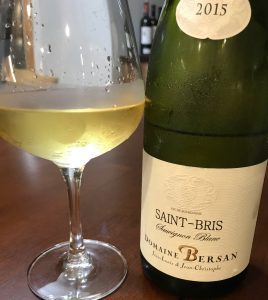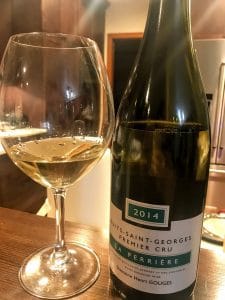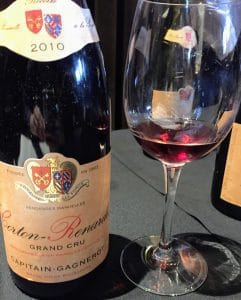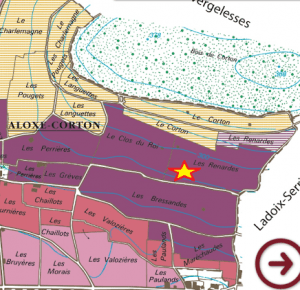
One believes things because one has been conditioned to believe them. — Aldous Huxley, Brave New World
Pop quiz, wine geeks.
1.) What is the white grape of Burgundy?
If you know enough to be dangerous with a restaurant wine list or in a wine shop, then you probably didn’t hesitate to answer “Chardonnay”.
And for the most part, you’d be right.
But also a little wrong.
Some of the best “intro to wine” texts around like Karen MacNeil’s The Wine Bible, Kevin Zraly’s Windows on the World Wine Course and Madeline Puckette’s Wine Folly will teach you that it is easy to start getting a grasp of Burgundy.
Just remember that there is only two grapes–Pinot noir and Chardonnay.
It’s a reflex condition to think with Burgundy that if its red, it’s Pinot noir. If it’s white, then Chardonnay. Sure, everything else about Burgundy with it’s 100 appellations and intricate classification system of 23 regional AOCs, 44 villages, 33 Grand Crus, 585 Premier Crus and countless named lieu dits is enough to make your head spin—but it’s easy to nail the grape varieties. Right?
“But I don’t want comfort. I want God, I want poetry, I want real danger, I want freedom, I want goodness. I want sin.” — Aldous Huxley, Brave New World

A Sauvignon blanc produced less than 20 km from the heart of Chablis’ Grand Cru
I started working on the Wine Scholar Guild‘s Bourgogne Master Level Program lead by Don Kinnan with the desire to get more comfortable with Burgundy. But it wasn’t long before I found myself diving head-first into a rabbit hole that would shake me out of my comfort zone but introduce me to a world far more exciting than the one I began studying.
As Allen Meadows, the Burghound, is fond of saying–Burgundy is “the land of exceptions”.
It wasn’t long before the first exceptions started blowing in like the north wind across the Yonne. Here, in the land of Chablis, we have the Auxerrois where grapes like Sauvignon blanc run wild in Saint-Bris and Melon de Bourgogne (the grape of Muscadet) in Vézelay.
However, the exceptions aren’t limited to obscure villages in the northern backwoods of Burgundy. Instead, in the heart of the Côte-d’Or we have the curious case of Pinot Gouges.
In the 1930s, Henri Gouges was inspecting his vineyards in the Nuits-St-Georges premier cru monopole of Clos des Porrets. He noticed that one of his red Pinot noir vines was producing white grape clusters. Intrigued, Gourge took cuttings from the vine and planted them in the NSG premier cru vineyard of La Perrières. His grandchildren still cultivate this “Pinot blanc” though instead of labeling it as that grape, the Gouges family describe Pinot Gouges as “Pinot noir that lost their color“. Regardless of what the vines are called–the fact still remains that in the middle of Chardonnay land, we have an exciting and distinctively non-Chardonnay white Burgundy being produced from a premier cru vineyard.

My notes on the Pinot Gouges “The color looks like a regular white Burg with some oak influence. On the nose, tree fruits of apples and pears but there is a lot of spice here–not oak spice but rather exotic spices.
On the palate there is a lot of weight and texture–things that would make me think of oak except for the complete absence of oak flavors. There is no vanilla, cinnamon, clove, allspice, etc.”
Now while it is technically
illegal to plant Pinot blanc in most of the Côte d’Or (though, again, there are exceptions), several producers still tend to legacy vines.
Inspired by bottles of Pinot blanc from the 1960s that aged remarkably well,
Domaine Méo-Camuzet sourced Pinot blanc vines from Alsace to plant in their Clos St Philibert vineyard in Flagey-Echézeaux. The wine produced from these vines is blended with Chardonnay and classified under Bourgogne Hautes-Côtes de Nuits AOC (as opposed to a village level Vosne-Romanée).
Then there is the case of Pinot Beurot (Pinot gris), the sneaky pink-skinned mutation of Pinot noir that can sometimes find itself interspersed among Pinot noir vines. Not content to just be an interloper, the grape plays a starring role in wines like Domaine Comte Senard Aloxe-Corton blanc that is 100% Pinot Beurot as well Domaine Lucien Boillot et Fils Les Grands Poisots sourced from a parcel of Pinot Beurot first planted in the Volnay vineyard in 1958. Not legally permitted to be called a Volnay, the wine is labeled under the basic regional Bourgogne appellation. Likewise, in the famed white wine vineyards of Puligny-Montrachet, Domaine Guillemard-Clerc has a little less than an acre of Pinot Beurot which goes into it regional Bourgogne blanc. In the Bourgogne Hautes-Côtes de Beaune AOC, Domaine Guillemard-Pothier à Meloisey also produces a Pinot Beurot.

My notes on the Cave de Genouilly Aligote “As if a Sauvignon blanc and an unoaked Chardonnay had a baby. Great mouthfeel with weight. Smooth but fresh.”
And this is not even getting into
the more widely known exception of Aligoté which has
its own AOC and has earned the affection of a literal “Who’s Who” of legendary Burgundy producers like
Aubert de Villaine,
Lalou Bize-Leroy,
Marquis d’Angerville and
Michel Lafarge.
Domaine Ponsot takes the love affair a step further to make
premier cru level Aligoté in the Morey-St-Denis monopole of Clos des Monts Luisants.
The faith in these producers to devote precious terroir to this obscure grape is a testament that there is something interesting about Aligoté that makes it stand out in the Chardonnay-saturated world of Burgundy. It’s high acidity enchants with racy and mouthwatering appeal that is balanced by a weighty mid-palate that gives a sense of lemon custard richness which can charm even the most traditional white Burgundy lover.
There is no doubt that Burgundy is home to some of the greatest expressions of Chardonnay. However, for the wine geeks conditioned to merely think White Burgundy=Chardonnay, there is brave new world of exciting white Burgs waiting to be discovered.






